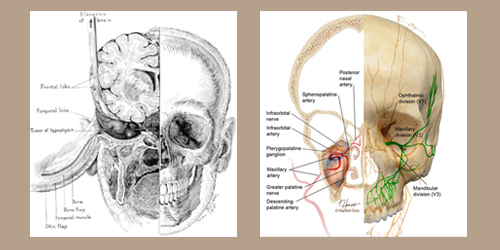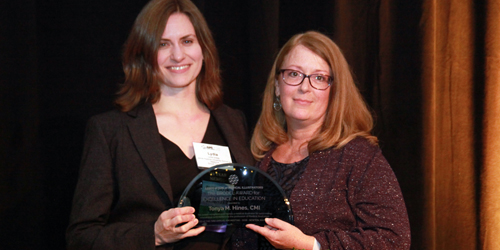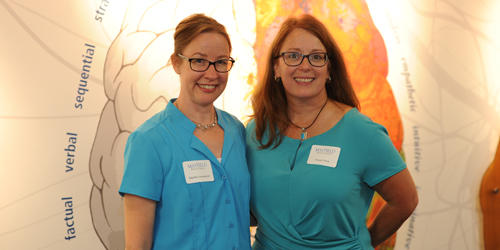
Turn to almost any patient education page on the Mayfield Brain & Spine website and you will see her artistic footprint. Open a neurosurgical journal, and you may see her work there, too. Tonya Hines, a certified medical illustrator, has been creating illustrations for Mayfield for 27 years. She has created thousands of images: brains, arteries, and lobes; spines, discs, and nerves; diseases, disorders, treatments, and technologies. Together, these images form the backbone of a career devoted to helping patients, physicians, and allied health professionals visualize medical conditions that affect the brain and spine.
Last week Ms. Hines, Art Director in Mayfield’s Communications Department, was honored with the Max Brödel Award for Excellence in Education at the 2018 Association of Medical Illustrators (AMI) annual meeting in Boston. The Brödel Award recognizes and honors a medical illustrator who has provided outstanding educational contributions to the profession.
View Ms. Hines’s work at GliaMedia.com >
Ms. Hines considers the award highly prized in her field because it connotes the values and ideals of its namesake. “Max Brödel is regarded as the father of modern medical illustration, having established the first academic program, Art as Applied to Medicine, at the Johns Hopkins School of Medicine in 1911,” Ms. Hines says. “While Brödel was devoted to his art, he was even more devoted to his students and to teaching the craft of medical illustration so that the profession would endure.”
“To be recognized alongside Max Brödel,¹ the artist who illustrated for Harvey Cushing, the father of neurosurgery, is a tremendous honor,” observes George Mandybur, MD, a Mayfield neurosurgeon.

The award honored Ms. Hines for her educational contributions as editor of the Medical Illustration Business Practices, for conducting the AMI’s salary and pricing surveys, and for her advocacy work on copyright legislation in Washington, D.C.

Ms. Hines says she discovered her love of drawing as a child. “I loved horses and drew them all over my grade school textbook covers — remember protecting your books with brown paper sacks? But it wasn’t until seventh grade, when my art teacher made us draw only the negative space, that it really clicked and I wanted to practice and get better and better. I recall using the grid technique to draw a leprechaun, and when I showed my parents, they thought I had traced it.”
A career aptitude survey in high school pointed Ms. Hines in the direction of her career. “I remember the guidance counselor handing me a piece of paper with a list of potential careers,” Ms. Hines recalls. “Medical illustrator was No. 2. I had never heard of such a thing, to do both art and science. My choice was made: that’s what I wanted to be when I grew up.”
Ms. Hines earned her bachelor of science in medical illustration from Ohio State University in 1990 and was working as a freelancer when her professor called to tell her about a temporary position with a Mayfield neurosurgeon that involved illustrating a neurosurgical atlas. “It was only to last until the book was completed, about 10 months,” Ms. Hines says.
But illustrating surgical series that depict multiple steps – including observing the surgery – can take more than a month. Thus the 10-month job stretched into 10 years, as Ms. Hines and her colleagues created more than a thousand drawings for the two-volume Atlas of Operative Microneurosurgery. In so doing, Ms. Hines secured a permanent position.

Seventeen years later, Ms. Hines is indispensable to Mayfield’s neurosurgeons as well as to researchers and specialists who contract for her work via Glia Media™. Her illustrations have appeared in several hundred peer-reviewed journals and, along with her storytelling guidance, in close to a thousand scientific lectures presented in Cincinnati and around the world.
“The impact that Tonya and her work have had on our organization is unquestionable,” says Tom Rosenberger, APR, Vice President of Communications at Mayfield. “Her contributions are reflected not only in the incredible artwork she creates, but also in her spirit, her curiosity, and her continuous drive to learn more, to continuously improve.”
Her passion for her work has never wavered.
“The brain is a mystery that we discover more about every day,” Ms. Hines says. “It’s gratifying when scientists and doctors tell me my illustrations helped get their paper accepted into a journal. But I’m most inspired by patients who send us letters and messages about our patient education materials on our website. When you suffer a brain tumor or aneurysm, it doesn’t just change your anatomy, it affects who you are — how you think, feel, and act. Nothing can be more frightening than that, and if my art can help them understand what’s happening, I feel like I’ve made a difference.”
— Cindy Starr
¹Patel SK. Max Brödel: His art, legacy, and contributions to neurosurgery through medical illustration. Journal of Neurosurgery 115(1): 182-190, 2011.